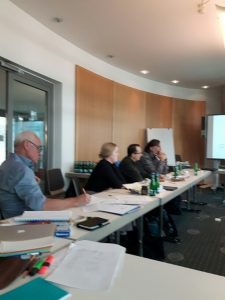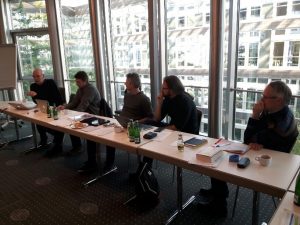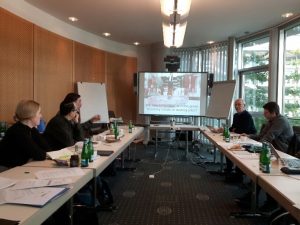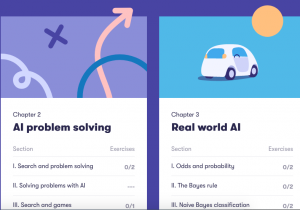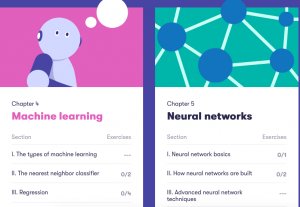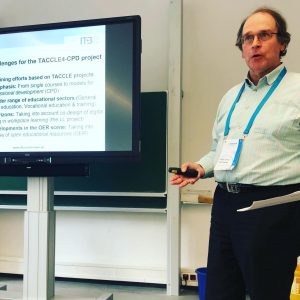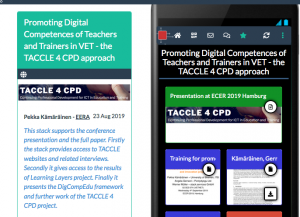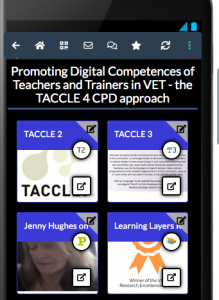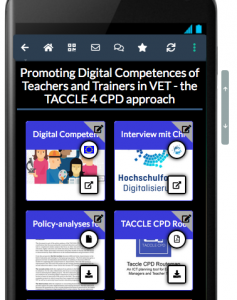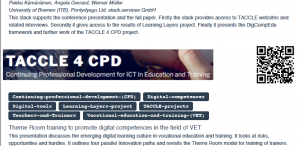Presenting my contributions to TACCLE4 CPD project – Part Two: Insights into the completed reports
In my previous post I have told that this is the season for producing a short description on the ongoing project TACCLE4 CPD for the regular reviewing in our institute and for finalising the contributions to the project. I have also explained, why our contribution to the TACCLE4 CPD project has needed more research-oriented work that was anticipated in the project design. In general, the partners working with general and adult education have been able to rely more directly on the work of previous TACCLE projects. These have promoted digital competences of teachers in general education with focus on classroom teaching. Moreover, when developing strategies and models for continuing professional development (CPD) these partners have perceived school directors, local educational authorities and national educational authorities as their target audiences.
For the work of ITB – as the German partner in the project – the task to develop strategies and models for promoting digital competences in the field of vocational education and training provides more complex challenges. The field of VET is not merely another educational sector (under educational authorities) but involves different learning venues, education and training providers and governance structures. Moreover, the promotion of digital competences of teachers and trainers is not merely a matter of digitization within education but requires understanding of digital transformation in working life. These challenges have been taken up in the following reports that have been produced for the TACCLE 4 CPD project.
Report 1 – Policy analyses: Raising awareness of multiple policies and initiatives
This report has been produced to cover policies and strategies at different educational levels and taking into account different governance models. The report draws attention to following characteristics of policies in the field of VET and to recent developments in innovation strategies to promote digital competences of different actors in VET:
- Distribution of power structures in different educational systems: The report makes transparent the differences between central and federal governance models in education.
- Distribution of functions and competences in dual systems of vocational education and training: The report presents the roles of different VET providers and stakeholders (companies, schools and intermediate training centres, chambers and governing bodies) and the regulations guiding different parties.
- Joint agreements, innovation programmes and strategic alliances: The report gives insights into joint agreements (between different bodies), innovation programmes (launched by central governments) and strategic alliances (at different levels for temporary actions in particular focal areas of VET development). In this context the report also informs of local initiatives.
- New frameworks at European and national level to promote digital comtences in education and training: The report discusses the key points of the European DigCompEdu framework as a general orientative framework for promoting digital competences in different educational sectors. In addition it discusses the more VET-specific accents that have been raised in the German study “Berufsbildung 4.0” (VET 4.0) that has outlined a future-oriented innovation programme.
Report 2 – Legacy of predecessor projects and finding new approaches to promote digital competences in the field of VET
This report has been produced to compare the training approaches that had been applied in the three prior TACCLE projects and at different phases of the Learning Layers project. In addition it gives an overview on more recent R&D projects in the field of VET. The report serves the following purposes:
- Creating awareness of the different project histories and process dynamics: In this respect the report gives brief overviews of the parallel project histories and different phases of work.
- Making transparent the role of co-design and piloting with new tools in the Learning Layers project: From this perspective the report analyses specific impulses that arise from this background in the project work.
- Providing insights into parallel R&D projects in education and training and their support for training of teachers and trainer: Here the report provides examples on support for teacher education, CPD measures for vocational teachers and CPD measures for trainers in enterprises.
- Providing insights into recent field interviews with vocational trainers (carried out as part of the TACCLE 4 CPD): Here the report presents trainers’ views on the prospects for linking the use of digital tools to vocational learning culture.
Report 4a – Research paper that draws conclusions for the development of CPD in the light of the analyses
This report has been produced to draw conclusions for a specific project contribution for the field of VET. The report serves the following purposes:
- Summarisation of the conclusions from the comparisons between predecessor projects: Here the report gives insights into the process dynamics, into the role of training measures and into the role of outreach activities.
- Raising awareness of different policy contexts for promoting digital competences in schools and in VET contexts: Here the report gives a brief overview of parallel possibilities.
- Drawing attention to the relevance of general frameworks or studies in the field of VET: Here the report reflects the role of the European DigCompEdu framework vis-à-vis the challenges in the field of VET – as outlined by the German framework study “Berufsbildung 4.0”.
- Raising awareness of different outreach approaches for innovations in school contexts and in VET contexts: Here the report draws upon experiences of the earlier TACCLE projects and on the outreach prospects identified after the Learning Layers project
- Drawing conclusions on the importance of TACCLE Routemap approach and the Theme Room training model (of the Learning Layers project) for shaping CPD concepts to promote digital competences in the field of VET.
Here it is worthwhile to note that the Report 3 – with focus on the use of Open Educational Resources (OER) in vocational learning contexts – is still under preparation. Then, on the basis of all above-mentioned reports it is possible to prepare the Report 4b – a reworked version of the Theme Room training model for promoting digital competences in the field of VET. (Initially the Theme Room model was developed in the Learning Layers project for training all trainers of a construction sector training centre.)
—
I guess this is enough for a progress report at the moment. During the next week I will be working with the report on the use of OER in VET contexts. Then we will see, how I can make progress with the report on the reworked Theme Room training model.
More blogs to come …
